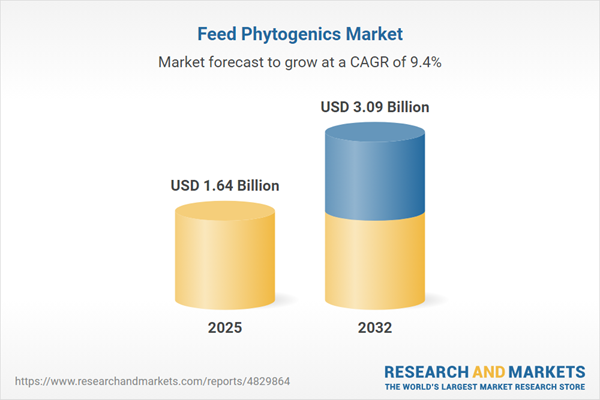Speak directly to the analyst to clarify any post sales queries you may have.
Senior leaders in animal nutrition are navigating a pivotal era as feed phytogenics rapidly transform industry standards, delivering advanced solutions for performance, sustainability, and regulatory compliance in livestock production.
Feed Phytogenics Market Snapshot
The Feed Phytogenics Market grew from USD 1.50 billion in 2024 to USD 1.64 billion in 2025. It is expected to continue growing at a CAGR of 9.43%, reaching USD 3.09 billion by 2032. Demand is being driven by evolving sustainability requirements, heightened regulatory controls, and escalating consumer focus on animal health and transparent supply chains. Major players in feed manufacturing and raw material sourcing are recalibrating their strategies to secure competitive advantage while addressing these shifting market forces.
Scope & Segmentation of the Feed Phytogenics Market
This report delivers a comprehensive analysis of the feed phytogenics landscape, covering essential trends, product innovations, and adoption patterns.
- Phytogenic Ingredient Types: Essential oils, flavonoids, oleoresins, saponins, and tannins utilized for antimicrobial, antioxidant, and digestive properties.
- Functionality: Targets include antimicrobial action, antioxidation, digestive stimulation, and growth promotion within species-specific nutrition systems.
- Product Forms: Formats comprise granules for efficient mixing, liquid concentrates for premix customization, and versatile powders.
- Livestock Applications: Solutions address the unique requirements of aquatic animals, poultry, ruminants, and swine through tailored phytogenic blends.
- Intended Applications: Products replace antibiotic growth promoters, offer antimicrobial effects, enhance digestion, and support general animal growth.
- Distribution Channels: Channels range from animal production operations and e-commerce platforms, to research institutions and retail outlets.
- Regional Coverage: In-depth insights for key subregions, including: Americas (North America, Latin America), Europe, Middle East & Africa (inclusive of leading European and Middle Eastern economies, plus major African markets), and Asia-Pacific (covering major Asian agricultural and consumer economies).
- Competitive Landscape: Market analysis covers leading entities such as Alltech, ORFFA, Delacon Biotechnik, Kemin Industries, Cargill, Pancosma, Phytobiotics, Natural Remedies, EW Nutrition, and Adisseo.
Key Takeaways for Senior Decision-Makers
- Technological advances in extraction and formulation have improved the consistency and bioavailability of phytogenic feed additives, fueling adoption across more species and geographies.
- Heightened regulatory scrutiny and the shift away from synthetic additives highlight the importance of compliance and transparent sourcing for maintaining market access.
- Increasing consumer demand for animal welfare and eco-friendly production is incentivizing brands to invest in certified and traceable phytogenic solutions.
- Digitalization—via real-time data capture, blockchain traceability, and precision livestock monitoring—enables validation of phytogenic benefits and claims.
- Innovators are leveraging strategic alliances, research partnerships, and regional processing hubs to secure raw material supply and diversify geographic risk.
Tariff Impact and Global Supply Dynamics
Recent United States tariffs on phytogenic raw materials have altered global supply chain structures, leading producers to reassess sourcing and inventory approaches. Local extraction and regional supplier partnerships are being established to minimize tariff exposure and maintain access to key compounds. As a result, regions with existing herbal industries are competing more actively, diversifying sourcing, and enhancing supply chain resilience. This dynamic is shaping pricing structures and driving broader shifts in global trade flows.
Methodology & Data Sources
This analysis draws on triangulated research across primary and secondary channels. In-depth interviews with executives, technical experts, and procurement managers complement a rigorous review of published research, regulatory filings, and company disclosures. Market trends are corroborated through cross-verification with expert panels and regional validation workshops, ensuring robust and actionable insights.
Why This Report Matters
- Enables leaders to align R&D and sourcing strategies with shifts in regulation, consumer preference, and supply chain requirements specific to the feed phytogenics sector.
- Delivers actionable segmentation insights to support effective product development, market entry, and partnership decisions.
- Equips stakeholders with a strategic view of technological advancements and risk mitigation approaches, enhancing planning for long-term competitiveness.
Conclusion
The evolving Feed Phytogenics Market offers considerable opportunity for growth and competitive differentiation. By integrating market intelligence with a focus on innovation and partnership, industry leaders can position their organizations to achieve sustainable success in a complex global landscape.
Additional Product Information:
- Purchase of this report includes 1 year online access with quarterly updates.
- This report can be updated on request. Please contact our Customer Experience team using the Ask a Question widget on our website.
Table of Contents
3. Executive Summary
4. Market Overview
7. Cumulative Impact of Artificial Intelligence 2025
Companies Mentioned
The companies profiled in this Feed Phytogenics market report include:- Alltech, Inc.
- ORFFA BV
- Delacon Biotechnik GmbH
- Kemin Industries, Inc.
- Cargill, Incorporated
- Pancosma SA
- Phytobiotics Futterzusatzstoffe GmbH
- Natural Remedies Pvt. Ltd.
- EW Nutrition
- Adisseo
Table Information
| Report Attribute | Details |
|---|---|
| No. of Pages | 193 |
| Published | November 2025 |
| Forecast Period | 2025 - 2032 |
| Estimated Market Value ( USD | $ 1.64 Billion |
| Forecasted Market Value ( USD | $ 3.09 Billion |
| Compound Annual Growth Rate | 9.4% |
| Regions Covered | Global |
| No. of Companies Mentioned | 11 |









